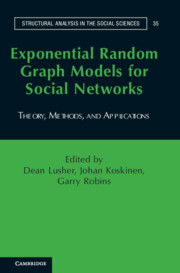Book contents
- Frontmatter
- Contents
- List of Figures
- List of Tables
- 1 Introduction
- Section I Rationale
- 2 What Are Exponential Random Graph Models?
- 3 Formation of Social Network Structure
- 4 Simplified Account of an Exponential Random Graph Model as a Statistical Model
- 5 Example Exponential Random Graph Model Analysis
- Section II Methods
- Section III Applications
- Section IV Future
- References
- Index
- Name Index
3 - Formation of Social Network Structure
Published online by Cambridge University Press: 05 April 2013
- Frontmatter
- Contents
- List of Figures
- List of Tables
- 1 Introduction
- Section I Rationale
- 2 What Are Exponential Random Graph Models?
- 3 Formation of Social Network Structure
- 4 Simplified Account of an Exponential Random Graph Model as a Statistical Model
- 5 Example Exponential Random Graph Model Analysis
- Section II Methods
- Section III Applications
- Section IV Future
- References
- Index
- Name Index
Summary
Tie Formation: Emergence of Structure
It is not always recognized that an exponential random graph model (ERGM) carries theory in the form of assumptions about networks, network processes, and social structures. We can think of “ERGM theory” as network metatheory because it is not specific to a particular network process. It is a theoretical perspective within which more specific network theories may be investigated. The essence of ERGM theory is the formation of social structure through the accumulation of small local substructures and, ultimately, through the formation of individual ties into the patterns of those substructures.
Formation of Social Ties
ERGMs are first and foremost concerned with explaining the patterns of ties in a social network. This tie-based approach of ERGMs permits answers to some questions but not others. A standard ERGM is not a model focused on predicting outcomes for individuals in the network (so called diffusion or social influence models); instead, it is about revealing patterns that may enable inferences on tie formation processes, including social selection processes where network ties are predicted from the attributes of the network actors.
Information
- Type
- Chapter
- Information
- Exponential Random Graph Models for Social NetworksTheory, Methods, and Applications, pp. 16 - 28Publisher: Cambridge University PressPrint publication year: 2012
Accessibility standard: Unknown
Why this information is here
This section outlines the accessibility features of this content - including support for screen readers, full keyboard navigation and high-contrast display options. This may not be relevant for you.Accessibility Information
- 15
- Cited by
